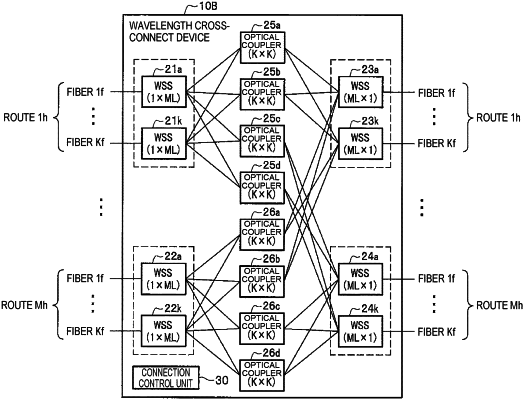| CPC H04J 14/0212 (2013.01) [H04Q 11/0003 (2013.01)] | 8 Claims |

|
1. A wavelength cross-connect device configured to perform relaying for changing, using WSSs (Wavelength Selective Switches), routes of optical signals transmitted from M routes, in which K optical fibers are grouped for each of the routes, on an input side to output the optical signals to respective optical fibers of M routes on an output side, the wavelength cross-connect device comprising:
M×K first WSSs each including a 1 input port connected to each of the optical fibers of each of the routes on the input side and M×L output ports, wherein L is a positive integer L≤K;
M×K second WSSs each including a 1 output port connected to each of the optical fibers of each of the routes on the output side and M×L input ports; and
2×M×L optical couplers each including K input ports connected to output ports of each of the first WSSs and K output ports connected to input ports of each of the second WSSs, wherein
the input ports of each of the optical couplers are connected to the output ports of respective first WSSs of the first WSSs,
the input ports of each of the optical couplers are connected to the output ports of the first WSSs and the output ports of each of the optical couplers are connected to the input ports of the second WSSs such that the optical signals input from the optical fibers in each of the routes on the input side are capable of being output to the optical fibers in each of the routes on the output side, respectively, and
when the optical signal input from the optical fiber of the route is an optical signal subjected to wavelength division multiplexing with a wavelength division multiplexing number T, each of the first WSSs includes a demultiplexer configured to demultiplex and output an optical signal obtained by wavelength division multiplexing of the optical signal, which is input from the optical fiber of the route, with a wavelength division multiplexing number T, T switches configured to selectively output demultiplexed optical signals having respective wavelengths and including a 1 input port and ML output ports, and T multiplexers configured to multiplex and output the optical signals output from the respective switches and ML input ports and a 1 output port.
|